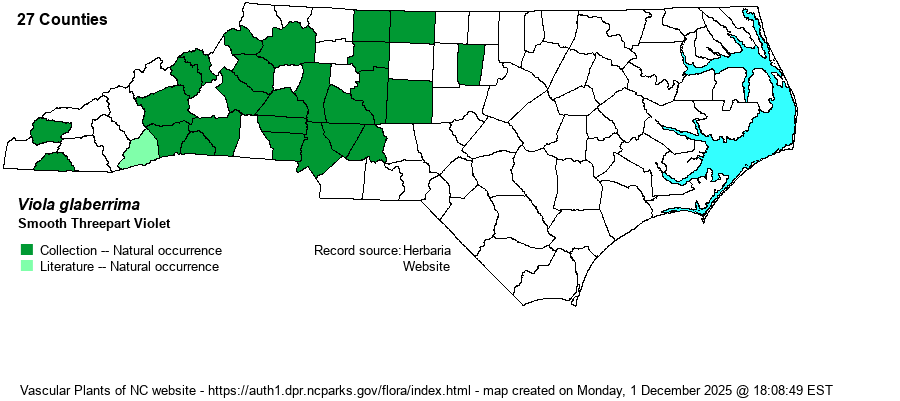| Author | (Gingins) H. House | |
| Distribution | Scattered over the Mountains and the Piedmont, east to Orange County. Recently split out from V. tripartita; has by some authors been listed as a variety of that species. Specimens from Cabarrus, Caldwell, Randolph and Yancey counties were mapped by Radford, Ahles, and Bell (1968), but not found in searches of NCU and SERNEC herbaria in September 2024. There are only a very few recent photos on iNaturalist that are correctly identified.
PA and KY south to northwestern SC. Not known from TN. | |
| Abundance | Despite specimens from 23 counties, this is a scarce species and in clear and strong decline in recent decades. Now very rare to rare; probably deserves to be on the Watch List or tracked as Significantly Rare, as there are apparently no recent collections! However, there are three recent photos on iNaturalist that seem correct. In late 2022, the NCNHP added the species to its list as Watch List (W7), with a State Rank of S1S3 owing to complete uncertainty as to how truly rare it is currently. The editors suggest a rank of S1S2, as there seem to be few current sites for it (a search through SERNEC in 2024 yields post 2000 records from only Davidson, Lincoln, and Mecklenburg counties). | |
| Habitat | It occurs essentially only on rich, high pH forested soil; mostly in Basic Mesic Forests and cove forests, on rich lower slopes and adjacent bottomlands. V. tripartita occupies the same habitats and the 2 can sometimes be found together. | |
| Phenology | Flowers and fruits from late March to early May. | |
| Identification | This is a caulescent violet, with a stem to 6-9 inches tall, and 2-4 leaves emerging near the top of the stem. These leaves are triangular and about 1.5-2 inches long and about half as wide, with a truncate or slightly cuneate base. The yellow flowers are raised slightly above the leaves. The similar V. tripartita (strict sense) has -- as the Latin name says -- leaves strongly 3-parted. V. hastata has mottled leaves above and leaves usually with hastate bases. Other yellow violets that are caulescent have leaves more heart-shaped and usually with cordate bases. | |
| Taxonomic Comments | Considered within V. tripartita in most recent references, either as a variety -- var. glaberrima -- or lumped completely. RAB (1968) included it as V. tripartita var. glaberrima.
General note on Viola: In 2009-10 B.A. Sorrie (website map editor) went through the whole collection at NCU, annotating all specimens against those verified by experts in the genus. The range maps in RAB (1968) have been changed accordingly. More recently, Harvey Ballard and colleagues are in the process of revising all Eastern and Southeastern Viola, and have annotated all specimens at NCU in July 2024. They recognize additional species not in RAB or in previous editions of Weakley et al.; we will follow updated editions of Weakley et al. in recognizing them. Species range maps have been adjusted to account for identification changes. | |
| Other Common Name(s) | Smooth Yellow Violet -- though V. eriocarpa usually is named as this. | |
| State Rank | S1S3 [S1S2] | |
| Global Rank | G5T3? [G3?] | |
| State Status | W7 | |
| US Status | | |
| USACE-agcp | | |
| USACE-emp | | |

